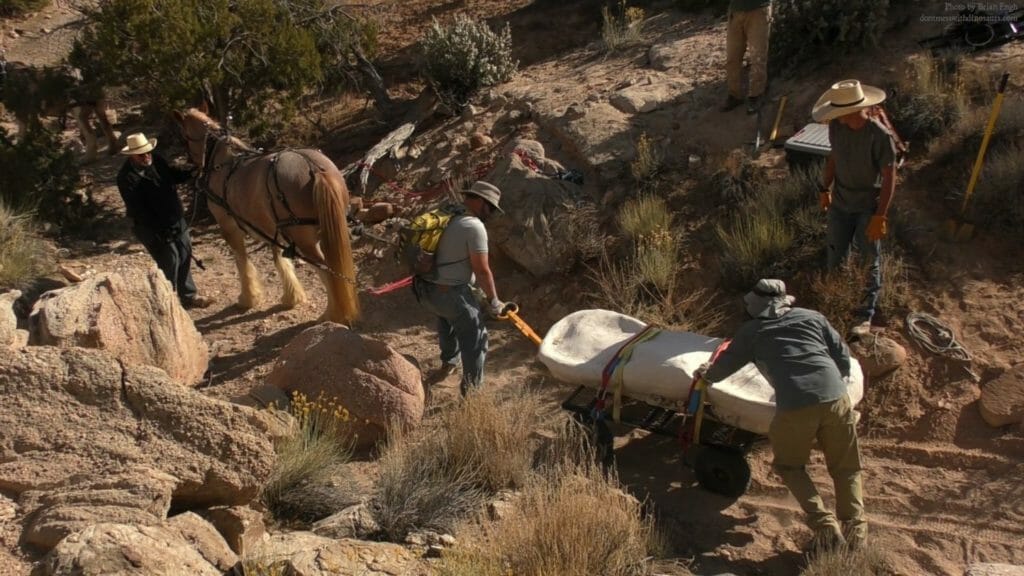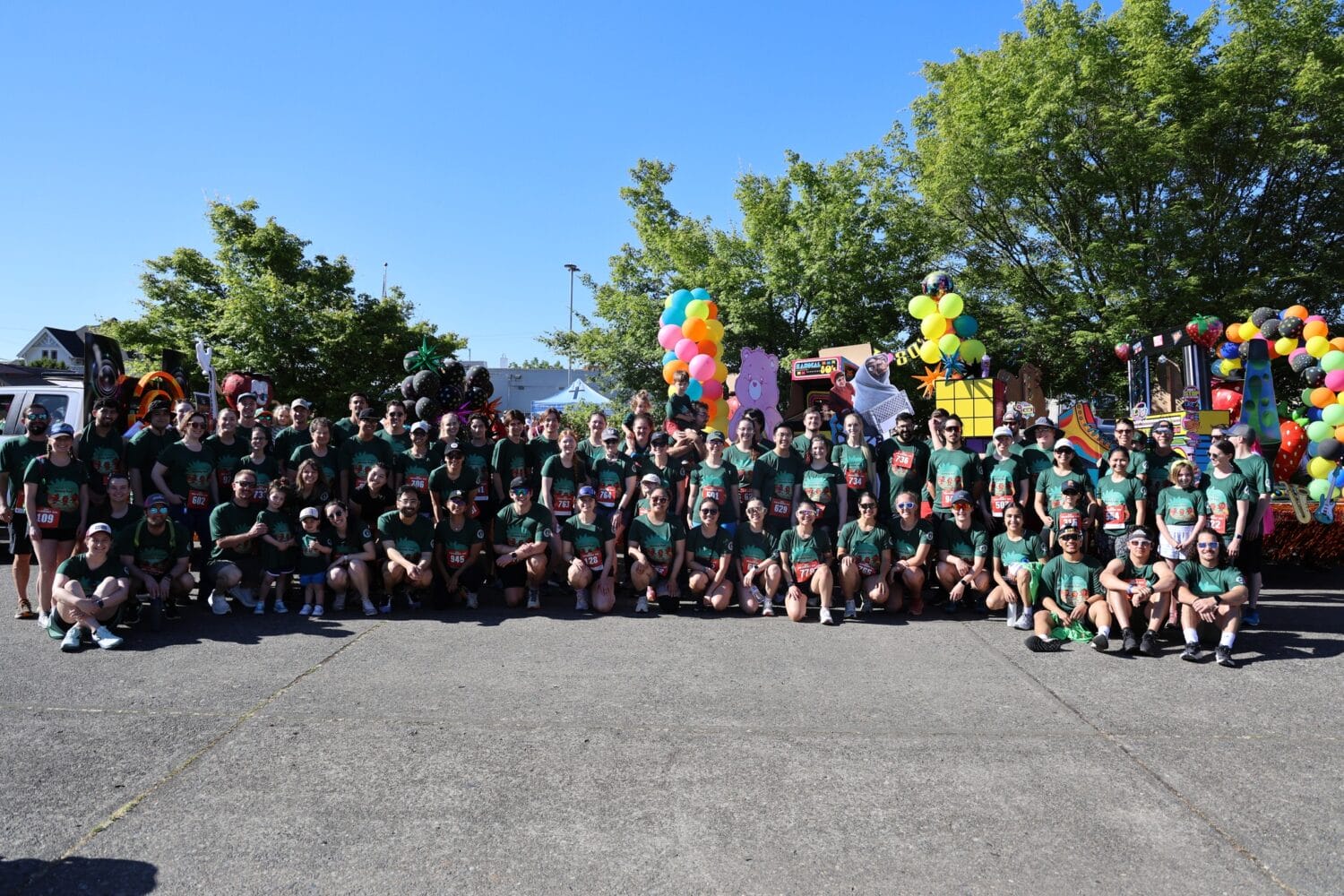WesternU paleontologist helps recover rare Brachiosaurus in Utah

A team of paleontologists from Western University of Health Sciences in Pomona, California, and the Utah Field House of Natural History State Park Museum in Vernal, Utah, has recovered a 6-foot, 7-inch humerus (upper arm bone) belonging to the rare, 30-plus-ton dinosaur Brachiosaurus from the desert of southern Utah.
The giraffe-like Brachiosaurus is distinguished by its long front legs, deep chest, and long neck. This is only the third humerus of a Brachiosaurus ever found – and the first in Utah. The bone and its surrounding rock, enclosing plaster and burlap “field jacket” weighed more than 1,000 pounds and were removed with the assistance of two Clydesdale horses.
The humerus will make its first public appearance at an unveiling in the lobby of the Utah Field House of Natural History State Park Museum, 496 East Main St., Vernal, Utah, at 11 a.m. Thursday, Jan. 30, 2020. The discovery is also the subject of a documentary, Jurassic Reimagined, created by Brian Engh. Part 1 is available to view below or visit his YouTube channel, Brian Engh Paleoart: https://www.youtube.com/user/DinosaursReanimated/videos.
The site was found in May 2019 by Engh, a paleoartist. The humerus was removed in October after permits were cleared and after securing the assistance of a horse team. After the bone was covered in plaster and burlap to immobilize it within sand, soil, and mudstone, it was dragged to a utility wagon that hauled it out of the remote site across rugged terrain by the horse team of Darla and Molly the Clydesdales, led by Wes and Resha Bartlett of Naples, Utah.
Despite being one of the most famous dinosaurs from the Late Jurassic-age Morrison Formation of the western United States, Brachiosaurus is a particularly rare dinosaur, outnumbered by an up to 20-to-1 ration by specimens of other species of dinosaurs. Team member John Foster of the Utah Field House of Natural History, a veteran of 29 seasons working in the Morrison Formation, said, “This is the first time I’ve even seen a Brachiosaurus in the field. Collecting one is a rare treat!”

WesternU College of Osteopathic Medicine of the Pacific and College of Podiatric Medicine Associate Professor Mathew Wedel, PhD, assisted with the discovery and excavation of the giant bones. Wedel has loved dinosaurs since he was 3 years old, and started working with dinosaur fossils in 1996. The team first visited this site in 2014, and after five years of work found not only the humerus but also several fossil plants in the surrounding area, which will tell them more about the Brachiosaurus’ environment.
“We are excited about the progress we’ve made so far, and we’re excited to now have a place to go back to where hopefully more big bones are waiting for us,” Wedel said. “The plants are almost as exciting to me as the brachiosaur because we’re not just headhunting. We’re not stamp collecting. We want to understand the world these animals lived in. We’re trying to be biologists of the past.”

The large bone is being prepared in the paleontology lab at the Utah Field House of Natural History State Park Museum in Vernal, Utah, and will be visible to the public during this process.
The project was funded by the Friends of the Utah Field House, Western University of Health Sciences, and Engh/dontmesswithdinosaurs.com. Permitting partners included the Utah Geological Survey, Natural History Museum of Utah, and Bureau of Land Management.
Brachiosaurus – Giant, Famous, and Rare
- Brachiosaurus is a rare element of a Late Jurassic fauna of the Rocky Mountain region that also included Camarasaurus and more distant cousins such as Diplodocus, Apatosaurus, and Individuals probably weighed more than 30 tons as adults
- Brachiosaurus was first found in 1900 in Grand Junction, Colorado, by paleontologist Elmer Riggs and his crew; the specimen, found in the Morrison Formation, is now at the Field Museum of Natural History in Chicago
- In the Morrison Formation there are 200-plus individuals of Camarasaurus known, 100-plus each of Diplodocus and Apatosaurus/Brontosaurus – and only about 10 individuals of Brachiosaurus
- Those 10 confirmed Brachiosaurus specimens come from just eight localities — four in Colorado, one each in Oklahoma and Wyoming, and two in Utah (this new site and one near Jensen)
- The humerus of Brachiosaurus is especially rare. Only two have been found in the past 120 years, and they have been collected only approximately every 60 years – the original in 1900, another around 1955, and now this one. The new one is the most complete of the three
- The new specimen includes more than the right humerus. The more fragmentary left humerus was found eroding down a nearby gulch, and several rib fragments and other bones were collected from the same area
- The humerus is approximately 79 inches (6.6 ft) long, taller than anyone on the team that collected it!
- The site is in rough and remote terrain, and the Clydesdales saved what would have been many sore backs and injuries if the bone had had to come out fully under human power – the horses made it look easy
- The humerus was found at a site low in the Morrison Formation, and the specimen may be the geologically oldest Brachiosaurus yet found from the rock unit, showing that this dinosaur appeared at the beginning of Morrison times
Additional Information
- The Utah Geological Survey, Natural History Museum of Utah, and Bureau of Land Management helped with permit clearance for the team’s fieldwork
- Vertebrate fossils may only be collected under permit on State and Federal lands. “If you make a discovery like this, reach out to your local public lands office, such as the Bureau of Land Management or the National Park Service, or your local museum, and they can let paleontologists know about your find,” says team member ReBecca Hunt-Foster, park paleontologist at Dinosaur National Monument. “Often members of the public who help discover fossils such as these can assist with the excavation. Some fossils, if they prove to be a new or unique find, are named after their ”
- For information on the Morrison Formation in general and this bone in particular, see the documentary series Jurassic Reimagined: https://www.youtube.com/user/DinosaursReanimated/videos



